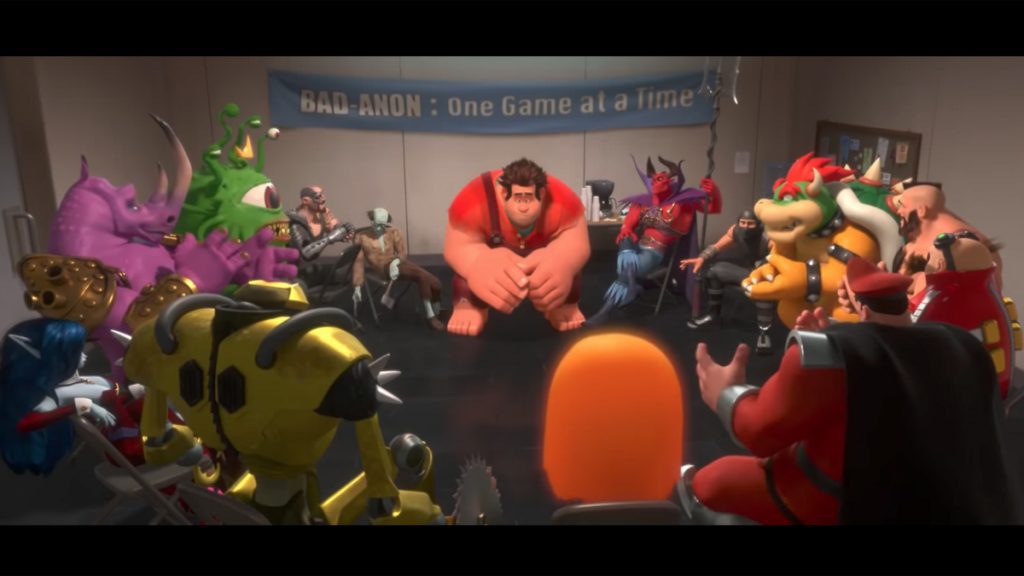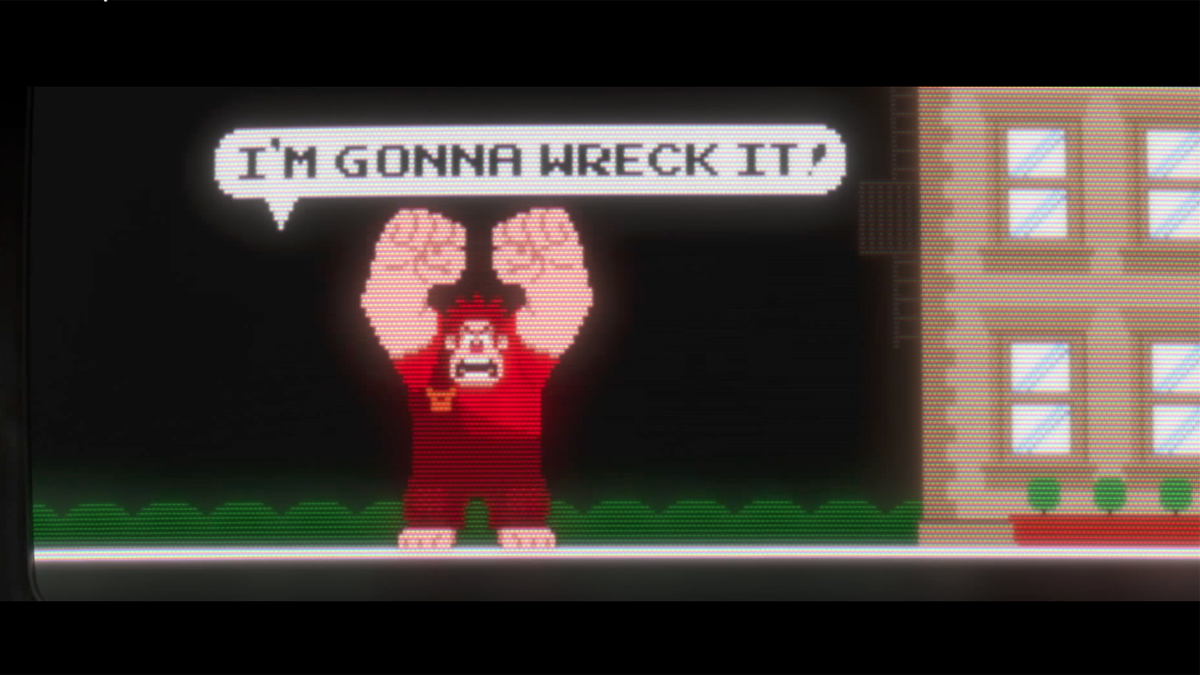Core Data:
- Vision: Self-aware videogame characters
- Type: Popular culture – films
- As Seen In: Wreck-It Ralph, Ralph Breaks the Internet
- Envisioned: 2015-2018
- Visionaries: Rich Moore (director); Phil Johnston, Jennifer Lee (screenwriters)
- Target Date: Present day
Overview:
What Toy Story did for the secret life of a child’s playthings, Wreck-It Ralph did for videogame characters. The hit 2015 Disney animation imagined an arcade where heroes and villains were self-aware, and could leave their own games to muck abot in other game worlds. Unfortunately, this became rather problematic when Wreck-It Ralph – the demolition happy bad guy in Fix It Felix Jr – began to question his lot in life, and tried to crossover to the light side. His game was subsequently left in disarray…
A few years later, sequel Ralph Breaks The Internet introduced Ralph and his new BFF, Vanellope Von Schweetz, to the even wider world of the world wide web. This vision of the internet stretched way beyond what Sir Tim Berners-Lee originally envisioned, turning the information super highway into a vast city packed with familiar brands, and – this being the ’net – some very annoying pop-ups.
But perhaps the most ingenious thing about the two Ralph movies was the way it put a very human spin on a bunch of zeroes and ones – the same way Inside Out seamlessly turned a kid’s brain into a tense office environment. The films don’t stand up under scientific scrutiny, of course, but that doesn’t stop them being a fun, family-friendly vision of a multiverse.

Key Tenets:
- Hardware: In Wreck-It Ralph, a vast metaverse exists inside arcade machines of different vintages, ranging from old classics such as Asteroids, Pac-Man and Centipede though to newer models such as Street Fighter II and Dance Dance Revolution.
- The characters (both playable and non-playable) in the various games can move between cabinets via the power cables in Litwak’s Arcade.
- They can also meet in the central hub of Game Central Station.
- In Ralph Breaks The Internet, arcade owner Stan Litwak instals a wifi router that gives the game characters access to the world wide web, via fibre optic cables.
- Once inside the internet, there are no limits to the characters (and humans) Ralph and his best friend Vanellope Von Schweetz can interact with.
- Experience: Arcade game characters are sentient – the actions they perform on screen are effectively performances they’ve been programmed for.
- Characters can respawn indefinitely within their own games. If they die somewhere else, however, their deaths will be final.
- If characters start to deviate from their primary programming, they manifest as glitches in the game. In other words, they create a terrible user experience that will probably prompt the arcade owner to disconnect the arcade cabinet and put it into storage.
- If a character is inside the machine when it’s turned off, they – and their world – are effectively deleted.
- Alternatively, if they’re inside Game Central Station when the switch is flicked on their game, they are left in a state of homelessness, with nowhere else to go.
- An officious surge protector manages the movement of characters between games.
- Some game characters evolve beyond their factory settings and want to try something new. For example, Ralph – the eponymous bad guy in fictional, Donkey Kong-esque retro-platformer Fix-It Felix Jr – has an existential crisis when he realises his entire life is an endless loop of smashing up buildings for the heroic Felix to repair. Not even joining Pac-Man ghost Clyde, Street Fighter II villains Zangief and M Bison, and Sonic The Hedgehog’s nemesis Dr Robotnik (or Eggman) at the Bad-Anon self-help group is going to help him out of his malaise.
- Instead, Ralph chooses to leave his own game to go looking for a medal in first-person shooter Hero’s Duty. Until he returns, the Wreck-It Ralph arcade unit will be “out of order”.
- It turns out there is a precedent for game characters going AWOL and breaking their arcade unit permanently. Turbo, the star of hit 8-bit racer Turbo Time, was so bitter about the arrival of the more advanced RoadBlasters title that he jumped games, hoping to top the leaderboard in the new racer. After leaving both games permanently out-of-order, Turbo moved to another car-based game, Sugar Rush, where he disguised himself as the despotic King Candy.
- In Ralph Breaks The Internet, the internet exists as a sprawling metropolis, with districts devoted to social media, finance, virus protection and more. There’s also a Dark Net region, which manifests itself as seedy city streets lifted right out of a film noir – you can almost smell the grime.
- Individual websites exist as buildings within the world wide web. Although the physical size of the exterior is not necessarily replicated by the interior – it turns out that websites are positively TARDIS-like – the architecture does tend to reflect the importance of the site. Tech giants like Google and Amazon exist in gleaming, impossible-to-miss skyscrapers, while homemade, DIY websites exist in dingy, hard-to-find offices way off the beaten track.
- The internet is populated by a mixture of netizens (the anthropomorphised programs who make the internet work) and the avatars of human users. When a user clicks on a particular website, their avatar is instantly transported to the building representing the site. Ebay, for example, manifests as a vast auction hall, with numerous auctioneers banging their gavels as users make their bids.
- For guidance, users can also pay a visit to KnowMore, a clever chap (okay, a search engine) who specialises in autofilling incomplete questions. If you’re looking for Desmond’s Tutus, he’s the guy to take you there.
- When walking around the internet, users are constantly bombarded by netizens carrying pop-up ads. Bouncer-like ad blockers move offending pop-ups along.
- Viruses are a threat. These dangerous creatures specialise in looking for insecurities and weaknesses, and can easily replicate and move between websites.
- If netizens linger too long in the Older Net, they will automatically be deleted.
- Websites specialising in pictures of cats are implausibly popular. Who’d have thought it?
- Company: In Wreck-It Ralph, physical games machines are manufactured by individual publishers, and brought together by arcade owners like Stan Litwak.
- In Ralph Breaks The Internet, the world-wide web is a huge city that anyone is free to enter – though most of the most visible real estate is owned by familiar tech giants.
- Economics: In the real-world, the arcade is funded by players feeding coins into the machines.
- The game characters in Wreck-It Ralph appear to work because it’s their calling, rather than looking for any kind of reward. In fact, the residents of Niceland in Fix-It Felix Jr appear to live a utopian existence fuelled by lots and lots of pie.
- The netizens in Ralph Breaks The Internet also seem happy to follow their programming, though some are doing better than others. Where pop-up ad flogger JP Spamley resides in a tiny, derelict space, BuzzzTube trending algorithm Yesss lives in the lap of luxury – that’s what happens when you have the power to decide whether something’s cool or not.
- Money can be made in the internet in numerous ways, from ecommerce to finding loot or collecting clicks on a site.
- IP: It might be quicker to list the intellectual property that isn’t in either of the Ralph movies…
- Alongside fictional game titles Fix-It Felix Jr, Hero’s Duty and Sugar Rush, Wreck-It Ralph features characters from Street Fighter II, Super Mario Bros, Sonic The Hedgehog, Q*bert, House Of The Dead, and many more.
- Ralph Breaks The Internet is even more of an IP grab bag. Although sites like BuzzzTube and KnowsMore were made up for the movie, YouTube, Google, eBay and Oh My Disney are very definitely real.
- The internet city is also a place where characters from other franchises can come out to play – though there is an unsurprising preference for Disney-owned properties. Characters from Star Wars, Marvel and Pixar all make appearances, though the movie’s biggest coup is uniting 14 Disney princesses, dating back to 1937’s Snow White.
State of Play (January 2022)
- Hardware: To a human user, the arcade machines in Wreck-It Ralph and the internet in Ralph Breaks The Internet work in exactly the same way as they do in the real world – it’s just what’s going on under the hood that’s different.
- It’s important to add that – contrary to what the Wreck-It Ralph movies and Tron suggest – computers are not home to millions of self-aware tiny cyber-people whose sole role in life is doing our bidding. The binary-based reality is much more mundane, though arguably more efficient…
- Experience: What self-respecting manufacturer would create a game with a self-aware lead character with the capacity to down tools and leave the game with no villain? Surely that’s a road that leads to complaints and even lawsuits.
- AI characters capable of responding to a player’s actions are now commonplace in games, but it’s not true intelligence or self-awareness – they always behave within pre-programmed parameters.
- While software designers have long been moving user interfaces towards visual representations – and they don’t come much more visual than the movie’s internet city – the anthropomorphised world wide web is also problematic. We’ve all had problems with web pages taking ages to load, but Ralph Breaks The Internet’s one-at-a-time queuing system for sites such as KnowMore and eBay is woefully inefficient.
- Company and IP: The movie is spot-on in its portrayal of everyone wanting a piece of the internet pie, with the tech giants by some distance the most visible presence.
- Ralph Breaks The Internet also nails Disney’s dominance of the pop culture landscape – though that may be something of a self-fulfilling prophecy.
- Economics: The monetisation of the internet in the movie – whether via direct financial transactions or clicks on social media platforms or ads – is also accurate, but not the end of the story.
- While Ralph and Vanellope setting out to make real-world money for themselves is, on many levels, ridiculous, software does exist to make users rich. Crypto trading bots, for example, can deal in cryptocurrency online as if they’re virtual stockbrokers.
Reality check: clever world building but utter nonsense
The way Wreck-It Ralph and Ralph Breaks The Internet turn videogames and the world wide web into living, breathing environments is a spectacular piece of world-building, and a compelling vision of a cartoon metaverse.
But in every other regard, the movies take artistic licence to almost preposterous levels. Just imagine the uproar if Donkey Kong had ever decided to down barrels and moonlight in Space Invaders…
Further reference
A self-confessed full-time geek, freelance journalist Richard has spent most of his career writing about sci-fi and fantasy – including more than a decade on staff for SFX magazine. He's particularly keen on franchises with "Star" in the title.



































